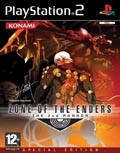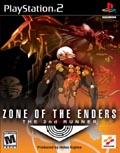PS2 Games
Zone of the Enders: 2nd Runner


TITLE Zone of the Enders: 2nd Runner
GENRE Action
PLATFORM PS2
DEVELOPER Konami
US PUBLISHER Konami Digital Entertainment
UK PUBLISHER Konami Digital Entertainment GmbH
NORDIC PUBLISHER Konami Digital Entertainment GmbH
ONLINE PLAY No
Media Screenshots:
SCREENS ADDED: 31 Mar-2006
Official Fact Sheet:
From Metal Gear Solid 2 producer Hideo Kojima comes the sequel to the anime-inspired mech combat game Zone of the Enders. In Zone of the Enders: The 2nd Runner, take control of a lightning fast mechanized robot and fight an evil militaristic force with new weapons, maneuvers, and tactics. Conflicts and settings of ZOE2 take place in cityscapes, enemy fortresses, and even in the depths of space.
- Fast-paced fighting action with unbelievable cinematic visuals.
- Target and destroy hundreds of enemies on screen at the same time.
- All new sub weapons enhance strategic play during combat.
- Gripping epic storyline.















